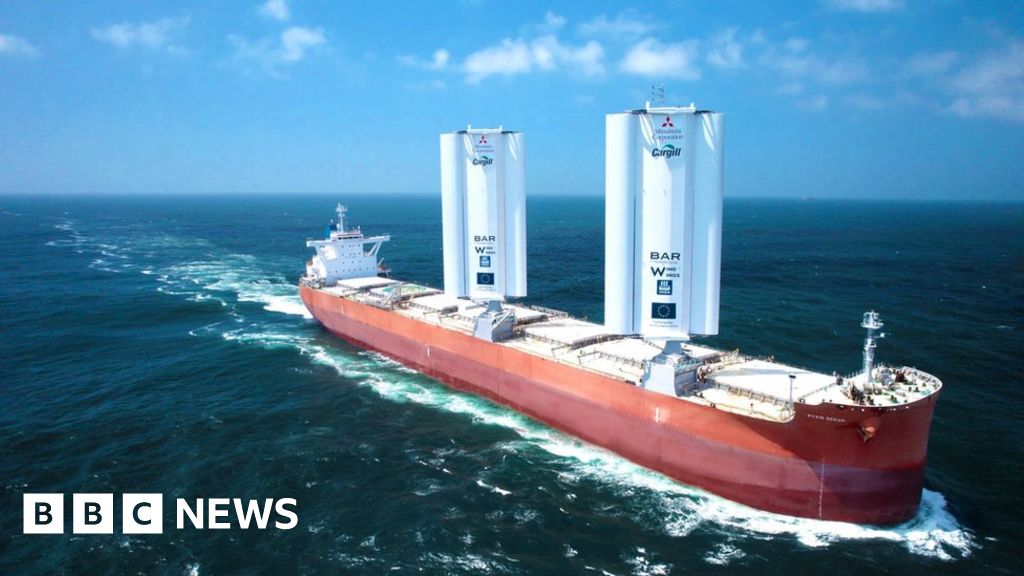A cargo ship fitted with giant, British-designed special wind-powered sails has set out on its maiden voyage.
Shipping firm Cargill, which has chartered the vessel, hopes the technology will help the industry chart a course towards a greener future.
Using the wing-sized rigid WindWings sails aims to cut fuel consumption and therefore shipping’s carbon footprint.
Using the wing-sized rigid WindWings sails aims to cut fuel consumption and therefore shipping’s carbon footprint.
The Pyxis Ocean’s first journey will be from China to Brazil – and will provide the first test real-world test of the wind-wing technology.
Folded down when the ship is in port, they are opened when it is at sea. They stand 123ft (37.5m) tall and are built of the same material as wind turbines, to make them durable.
Enabling a vessel to be blown along by the wind, rather than rely solely on its engine, could hopefully eventually reduce a cargo ship’s lifetime emissions by 30%.
Jan Dieleman, president of Cargill Ocean transportation, said the industry was on a “journey to decarbonise”. He admitted there was “no silver bullet” – but said this technology demonstrated how fast things were changing.
“Five, six years ago, if you would ask people in shipping about decarbonisng, they would say ‘well, it’s going to be very difficult, I don’t see this happening any time soon’,” he told the BBC.
A cargo ship fitted with giant, British-designed special wind-powered sails has set out on its maiden voyage.
Using the wing-sized rigid WindWings sails aims to cut fuel consumption and therefore shipping’s carbon footprint.
Shipping firm Cargill, which has chartered the vessel, hopes the technology will help the industry chart a course towards a greener future.
The Pyxis Ocean’s first journey will be from China to Brazil – and will provide the first test real-world test of the wind-wing technology.
Using the wing-sized rigid WindWings sails aims to cut fuel consumption and therefore shipping’s carbon footprint.
Using the wing-sized rigid WindWings sails aims to cut fuel consumption and therefore shipping’s carbon footprint.
The Pyxis Ocean’s first journey will be from China to Brazil – and will provide the first test real-world test of the wind-wing technology.
Folded down when the ship is in port, they are opened when it is at sea. They stand 123ft (37.5m) tall and are built of the same material as wind turbines, to make them durable.
Enabling a vessel to be blown along by the wind, rather than rely solely on its engine, could hopefully eventually reduce a cargo ship’s lifetime emissions by 30%.
Jan Dieleman, president of Cargill Ocean transportation, said the industry was on a “journey to decarbonise”. He admitted there was “no silver bullet” – but said this technology demonstrated how fast things were changing.
“Five, six years ago, if you would ask people in shipping about decarbonisng, they would say ‘well, it’s going to be very difficult, I don’t see this happening any time soon’,” he told the BBC.
#Pioneering #windpowered #cargo #ship #sets #sail
Note:- (Not all news on the site expresses the point of view of the site, but we transmit this news automatically and translate it through programmatic technology on the site and not from a human editor. The content is auto-generated from a syndicated feed.))



